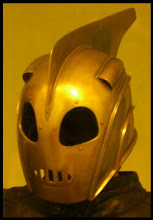I used a Sense 3D scanner to get the 1:1 dimensions and a rough shape to reference. From this I could start modeling a replacement.
Once I had a low-res model that matched the size of the original part, I found (after many many failures) that it would print successfully rotated up at an angle. I extruded some supports from a few edges to prop it up above the build plate. Here it is in ReplicatorG ready to be printed:
3D printing is surprisingly difficult. You'd think you could just drop in a model, hit a button, and wait for it to create it.. but there's a lot to it. Supports are important, and the rotation of the object will make a huge difference. You even need to decide whether or not it would print the model in pieces to assemble later. It may come out better if you do that, but experimenting is all part of the fun.
This test print with the low-res geometry turned out really well! It took a long time but it was worth it.
ReplicatorG adds all these extra supports around the model that are easily broken off when it's finished:
There are still some tweaks I need to do before printing out the high-res version, but now that I have a real, tangible piece I can hold, knowing what changes are needed is so much easier.
Not a bad start! But you may be thinking, "why doesn't he just buy a new one?" I'll admit that this method takes a lot of work, and in most cases it would just be easier to buy another. This piece, however, is for a Toyota Sera, which is so old and rare that Toyota has stopped stocking parts for it. In a situation like this where replacement pieces aren't readily available, having the ability to recreate or customize is huge, and it makes the whole experience more personal. Being able to print a door handle bezel may not seem like a big deal, but this makes me very excited for the future!






